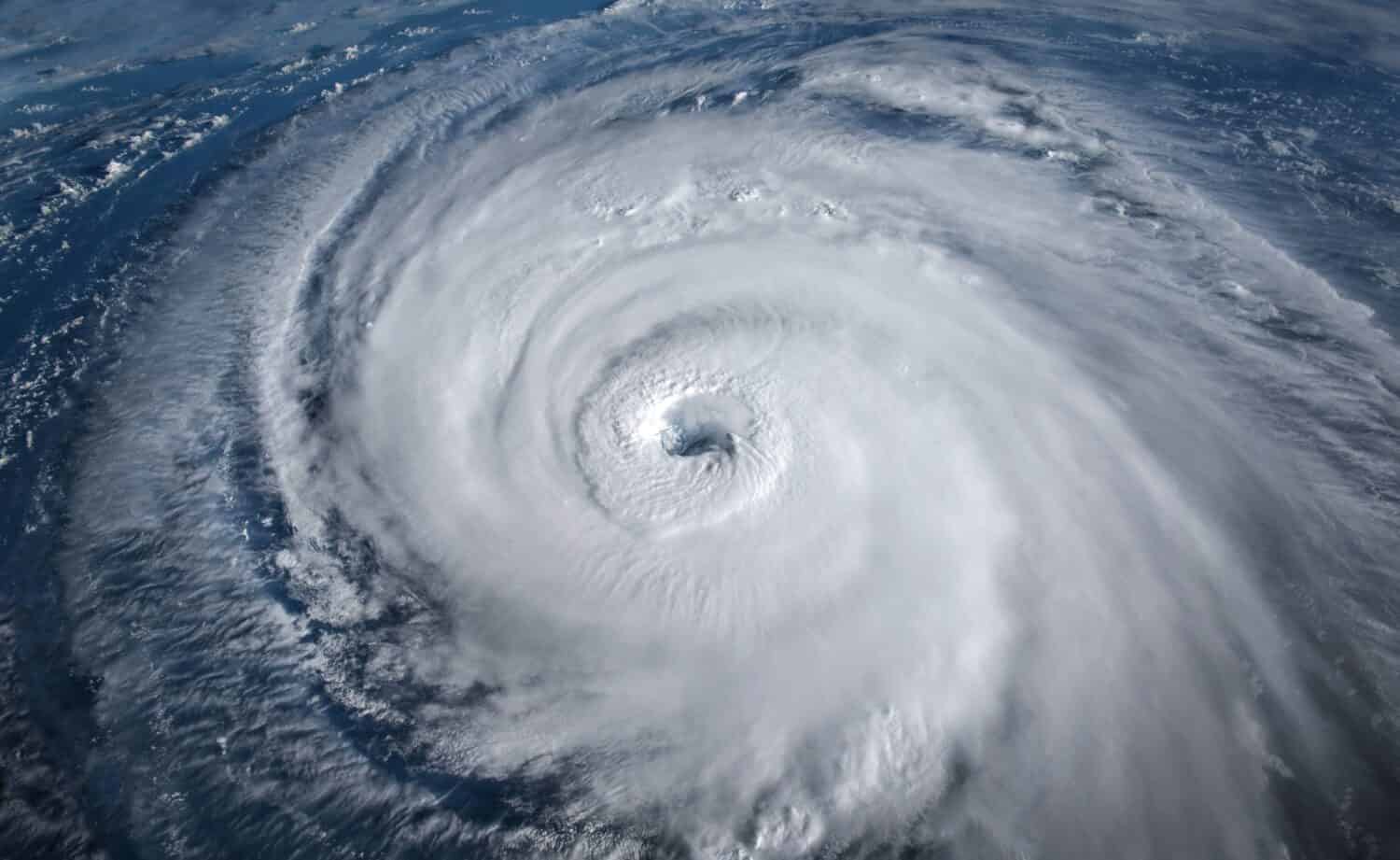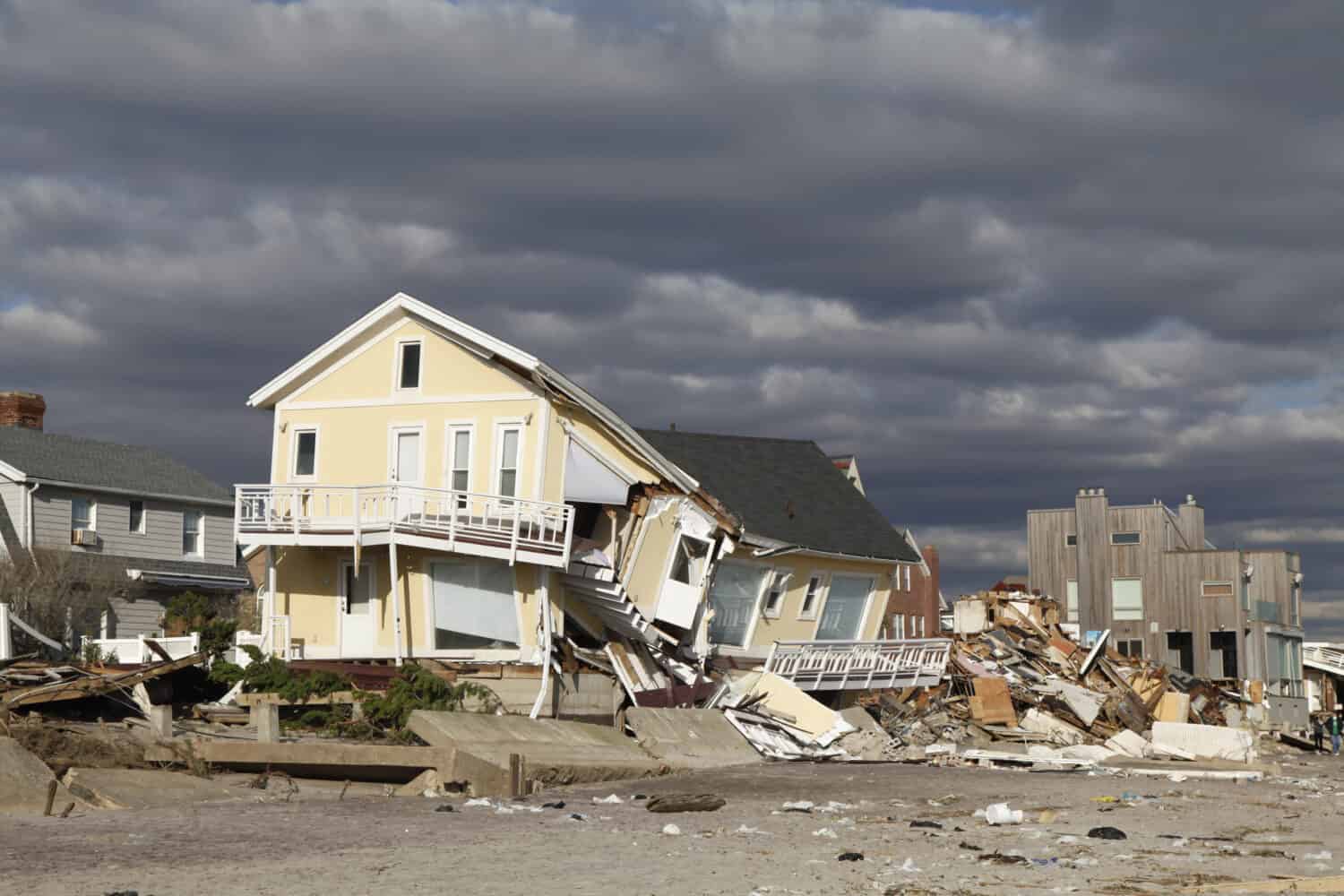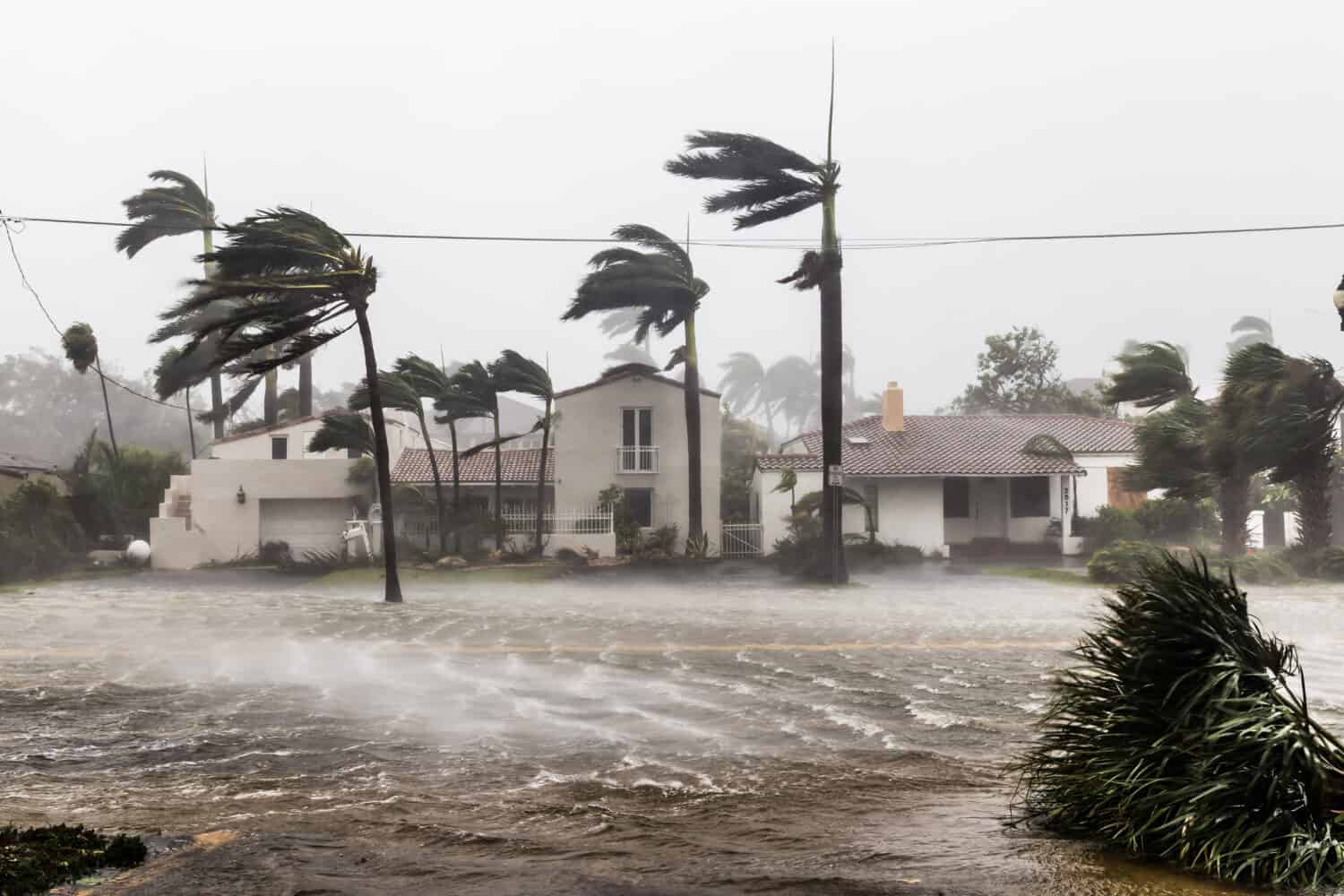Hurricane Henri and Hurricane Sandy were powerful tropical cyclones that each left a trail of destruction in their wake. With their immense strength and fierce winds, these natural disasters impacted various locations, causing significant damage, displacing communities, and leaving a lasting impact on the environment. In this article, we will explore Hurricane Henri vs. Hurricane Sandy, determining which storm was more destructive.
This article will delve into the details surrounding Hurricane Henri and Hurricane Sandy, including their duration, affected areas, category classification, economic costs, displacement figures, fatalities, and environmental repercussions.

Hurricane Henri and Hurricane Sandy had devastating effects.
©Triff/Shutterstock.com
Hurricane Henri Details
Duration and Category Classification
Hurricane Henri originated as a tropical depression in the Atlantic Ocean, gradually intensifying into a hurricane. From August 15 to August 25, 2021, Henri unleashed its wrath, impacting its affected regions. The hurricane was classified as a Category 1 storm on the Saffir-Simpson Hurricane Wind Scale, with maximum sustained winds of 60 miles per hour and recorded winds up to 75 miles per hour.
Locations Affected
Hurricane Henri’s path carved through various states along the northeastern coast of the United States, in addition to Bermuda and southern Nova Scotia. In the United States, the hurricane primarily impacted areas such as New York, New Jersey, Rhode Island, Massachusetts, Vermont, and Connecticut. These regions endured relentless rainfall, strong winds, storm surges, and subsequent flooding, leading to widespread destruction and chaos. Coastal communities bore the brunt of the storm, with many suffering from extensive damage to homes, infrastructure, and natural landscapes.
Economic Costs and Displacement
Hurricane Henri resulted in significant economic costs due to its destructive impact on communities and infrastructure. Preliminary estimates indicate that the storm caused billions of dollars in damages, with some estimates between 8 to 12 billion. The destruction of homes, businesses, and public infrastructure and the costs of recovery and rehabilitation left a substantial financial burden on the affected areas. Furthermore, the hurricane forced thousands of residents to evacuate their homes, resulting in widespread displacement. Emergency shelters were set up to accommodate those displaced by the storm, ensuring their safety and well-being during this challenging time.
Fatalities and Human Impact
Regrettably, Hurricane Henri resulted in two fatalities, amongst many injured. The storm’s powerful winds and torrential rains posed significant risks to human life. The recorded number of deaths resulting from the hurricane was two. Tragically, any loss of life serves as a stark reminder of the devastating power of natural disasters and the importance of preparedness and emergency response measures in mitigating their impact.
Environmental Consequences
In addition to its human toll, Hurricane Henri profoundly impacted the environment. The storm’s excessive rainfall and storm surge led to extensive flooding, endangering natural habitats and ecosystems. Coastal areas, in particular, experienced significant erosion and damage to fragile ecosystems such as salt marshes and barrier islands. The influx of freshwater from heavy rainfall also disrupted the delicate balance of estuaries, impacting aquatic species and their habitats. Additionally, the increased sediment runoff from land contributed to water quality degradation, further stressing the affected ecosystems.
Recovery and Resilience
In the aftermath of Hurricane Henri, affected communities rallied together to begin the arduous recovery and rebuilding process. Emergency response teams, volunteers, and government agencies collaborated to provide essential supplies, support, and resources to those in need. The resilience of the affected regions was demonstrated by their determination to restore normalcy and rebuild stronger, more resilient communities. The recovery process involved repairing damaged infrastructure, rehabilitating natural landscapes, and supporting the emotional well-being of the impacted individuals.
Overall, Hurricane Henri’s passage left a lasting impact on the affected regions. From its duration and category classification to its economic costs, displacement figures, injuries, and environmental consequences, we can not understate the devastation caused by this hurricane. However, in the face of such adversity, affected communities have shown remarkable strength and resilience, exemplifying the human spirit’s ability to overcome even the most formidable challenges posed by nature.

Hurricane Henri caused an estimated $8 to $12 billion in damages.
©andrejs polivanovs/Shutterstock.com
Hurricane Sandy Details
Duration and Category Classification
Hurricane Sandy, originally formed as a tropical depression in the Caribbean Sea, strengthened and developed into a hurricane. The duration of the storm lasted from October 22 through November 2, 2012. The storm affected a vast area, from the Caribbean to the northeastern United States. Sandy was classified as a Category 3 hurricane on the Saffir-Simpson Hurricane Wind Scale, as measured by the National Weather Service, boasting maximum sustained winds of roughly 115 miles per hour at its peak intensity.
Locations Affected
Hurricane Sandy had a widespread impact. It affected the Greater Antilles, Bahamas, the eastern United States, Bermuda, and eastern Canada. In the United States, the storm made landfall along the densely populated coastal areas of Florida, North Carolina, South Carolina, Washington D.C., Maine, New Hampshire, Virginia, Maryland, Delaware, New Jersey, Pennsylvania, Connecticut, and even affected areas further inland within the Northeast and Midwest. 24 U.S. states were affected in all. The coastal regions experienced the full force of Hurricane Sandy’s powerful winds, heavy rainfall, and storm surge.
Economic Costs and Displacement
Hurricane Sandy inflicted significant economic costs due to its unprecedented destruction. The storm caused an estimated $60 to $70 billion in damages, making it one of the costliest hurricanes in U.S. history. The devastation included the destruction of homes, infrastructure, businesses, and public utilities. Many people felt the economic impact in the immediate aftermath and the long-term recovery and rebuilding efforts required to restore affected communities.
Hurricane Sandy also resulted in the displacement of numerous individuals and families. Tens of thousands of residents had to evacuate their homes in the face of the impending storm. Many sought refuge outside the affected areas in emergency shelters, hotels, or with friends and family. The displacement of people added a layer of complexity to the recovery process. It highlighted the need for support and resources to help those affected to rebuild their lives.
Fatalities and Human Impact
Tragically, Hurricane Sandy caused a significant loss of life. The storm resulted in the deaths of approximately 230 individuals across the affected areas. Most fatalities resulted from drowning, falling trees, structural collapses, or accidents during the evacuation process. The human toll of Sandy underscored the importance of timely and effective emergency response measures and the need for improved infrastructure and community preparedness to mitigate the impact of future storms.
Environmental Consequences
Hurricane Sandy had profound environmental consequences, particularly in coastal areas but also further inland in the United States. The storm’sstorm’s powerful winds and storm surge led to widespread erosion, damaging fragile coastal habitats such as dunes, marshes, and beaches. The surge of seawater also penetrated inland, flooding low-lying areas and disrupting ecosystems. Hurricane Sandy’s environmental impact extended to marine habitats, including coral reefs, seagrass beds, and estuaries. The influx of freshwater and sediment runoff from heavy rainfall adversely affected water quality and aquatic species, leading to ecosystem imbalances.
In the aftermath of the storm in the coastal regions, various entities took action to restore and protect damaged natural environments. Coastal restoration projects, for example, aimed to rebuild and fortify vulnerable areas, which included dune replenishment and beach nourishment. These measures played a crucial role in promoting the resilience of coastal ecosystems, mitigating future damage, and safeguarding the natural habitats and species that call these areas home.
Recovery and Resilience
The recovery process following Hurricane Sandy was an immense undertaking that required extensive collaboration between government agencies, community organizations, and affected residents. Efforts focused on rebuilding damaged infrastructure, restoring essential services, and providing assistance to those affected. The resilience and determination of impacted communities were evident in their commitment to rebuilding stronger, more resilient neighborhoods that could better withstand future natural disasters.
Overall, Hurricane Sandy left an indelible mark on all areas affected. It caused widespread devastation and loss. From its duration and category classification to its economic costs, displacement figures, fatalities, and environmental impact, the hurricane serves as a stark reminder of the immense power of nature and the need for preparedness and mitigation strategies. The lessons learned from this tragic event continue to inform disaster management practices, aiming to better protect communities and the environment in the face of future challenges. When in comparison of Hurricane Henri vs. Hurricane Sandy, Hurricane Sandy makes a strong case for being incredibly destructive.

Hurricane Sandy was classified as a category 3 hurricane.
©Leonard Zhukovsky/Shutterstock.com
Hurricane Henri vs. Hurricane Sandy: Which Storm Was More Destructive?
When comparing the destructive impact of natural disasters, it is essential to consider various factors, including intensity, duration, affected areas, economic costs, displacement figures, and environmental consequences. By examining these aspects, we can gain insights into the scale and impact of each storm and better understand which was more destructive. So, let’s dissect which was more destructive, Hurricane Henri vs. Hurricane Sandy.
The Intensity and Category Classification
In terms of intensity, Hurricane Sandy surpassed Hurricane Henri as a Category 3 hurricane sustaining winds of roughly 115 per hour. Hurricane Henri, a Category 1 hurricane, had maximum winds of 75 miles per hour. In terms of sheer intensity, Sandy had a more destructive force.
Duration and Affected Areas
Both hurricanes had similar durations and had a similar path of impact. However, Hurricane Sandy affected a larger geographical area than Hurricane Henri.
Economic Costs and Displacement Figures
The economic costs resulting from Hurricane Sandy were staggering. The storm caused an estimated upwards of $70 billion in damages, making it one of the costliest hurricanes in U.S. history. Additionally, Hurricane Sandy displaced hundreds of thousands of people, forcing them to evacuate their homes and seek temporary shelter. Many became homeless. Though devastating in its own right, Hurricane Henri’s estimated damages were upwards of $12 billion, considerably less than Hurricane Sandy.
Fatalities and Human Impact
Both hurricanes tragically resulted in the loss of human lives. Hurricane Sandy caused approximately 230 fatalities across the affected regions. The storm’s intensity, widespread flooding, and high storm surge contributed to the loss of life. In contrast, Hurricane Henri’s impact in terms of fatalities resulted in two. However, it is crucial to note that any loss of life is significant and deeply mourned, regardless of the number of fatalities. The human impact of both storms underscores the devastating toll that hurricanes can have on affected communities.
Environmental Consequences
Both hurricanes had significant environmental consequences, particularly in coastal areas. Hurricane Sandy’s storm surge and excessive rainfall led to widespread erosion, damage to delicate coastal habitats such as dunes, marshes, and beaches, and disruption of ecosystems. The storm surge penetrated inland, causing extensive damage as far as the Midwest in the United States. Similarly, Hurricane Henri caused environmental damage, including coastal erosion, disruption of ecosystems, and water quality degradation. The influx of freshwater and sediment runoff from heavy rainfall stressed fragile ecosystems. However, detailed comparative analyses of the environmental consequences of the two storms are limited. However, with the intensity of Hurricane Sandy, the hurricane had more of a negative ecological impact.
To conclude, while Hurricane Henri and Sandy caused significant destruction and impacted countless lives, Hurricane Sandy stands out as the more destructive storm. Hurricane Sandy’s higher intensity, longer duration, larger geographical impact, higher economic costs, and greater loss of life contribute to its classification as the more destructive hurricane.

Hurricane winds can vary from roughly 75 to 160 miles per hour.
©FotoKina/Shutterstock.com
Industries Affected by Hurricane Henri and Hurricane Sandy
Hurricane Henri and Hurricane Sandy greatly impacted various industries near and far. As with all hurricanes, there are similarities in the industries affected and notable long-term effects. Some of the industries deeply affected include the following.
Tourism and Hospitality
Coastal areas, especially popular tourist destinations, experienced disruptions and setbacks in the tourism and hospitality industry. The hurricanes lead to cancellations of flights, hotel reservations, and vacation plans. The closure of beaches, attractions, and recreational activities affected local businesses, including hotels, restaurants, tour operators, and retail establishments, resulting in financial losses.
Transportation and Logistics
These hurricanes disrupted transportation networks, including roads, bridges, and airports, making it challenging for people and goods to move in and out of affected areas. Flight cancellations, temporary closures of airports, and restricted road access hindered the movement of both passengers and freight. The transportation and logistics industry faced delays, disruptions in supply chains, and increased costs associated with rerouting and rescheduling transportation routes.
Agriculture and Fishing
The agricultural sector, particularly crop production and livestock farming, experienced significant losses due to flooding, strong winds, and excessive rainfall. Fields were inundated, crops were damaged or destroyed, and livestock faced increased health risks. Additionally, the effect on the fishing industry due to storm conditions made it unsafe for fishermen to operate. It disrupted fishing activities, affecting the livelihoods of those dependent on the sector.
Retail and Small Businesses
These hurricanes adversely affected local businesses, including retail stores, restaurants, and small enterprises. Temporary closures, power outages, damage to infrastructure, and even complete loss limited their operations and caused financial hardships. The loss of business during and after the storm, coupled with the decline in consumer spending due to the disruption, hurt the retail sector and small businesses.
Construction and Real Estate
The construction and real estate industries faced challenges due to the damage caused by both hurricanes. Properties, including residential and commercial buildings, suffered structural damage, flooding, and even destruction. The need for repairs, renovations, and rebuilding efforts increased the demand for construction services, while delays in ongoing projects and the reduced availability of materials impacted the industry.
Energy and Utilities
The energy and utilities sector also experienced disruptions due to these hurricanes. Strong winds and falling trees damaged power lines, leading to widespread power outages. Utility companies had to work diligently to restore electricity to affected areas. However, the process often took days or even weeks, affecting residential and commercial customers. The impact each storm had on energy infrastructure, including oil refineries and natural gas facilities, also posed challenges for the energy industry.
Insurance and Financial Services
These hurricanes triggered a surge in insurance claims, impacting the insurance and financial services industry. Homeowners, businesses, and other entities affected by the storm sought compensation for property damage, loss of assets, and business interruptions. The increased volume of claims and payouts placed a strain on insurance companies and necessitated extensive assessment and processing efforts.
It is important to note that many more industries were affected by these hurricanes. And the severity of the impact on each industry varied based on the specific circumstances of each hurricane, including the storm’s intensity, duration, and path, as well as the preparedness and resilience measures in place in the affected regions.

Hurricanes can be classified on a scale of 1 to 5 on the Saffir-Simpson Hurricane Wind Scale.
©Evgeniyqw/Shutterstock.com
Conclusion
In comparing Hurricane Henri vs. Hurricane Sandy, it is evident that both storms had significant destructive impacts. However, Hurricane Sandy emerges as the more devastating hurricane due to its higher intensity, longer duration, larger geographical reach, higher economic costs, and greater loss of life. Numerous industries faced immense challenges in the aftermath of these hurricanes. And countless lives were changed forever by the destruction that unfolded. Understanding the differences between these storms allows us to appreciate the scale of destruction and the need for improved preparedness and resilience measures. By learning from these experiences, we can work towards better-protecting communities and mitigating the impact of future natural disasters.
Thank you for reading! Have some feedback for us? Contact the AZ Animals editorial team.







